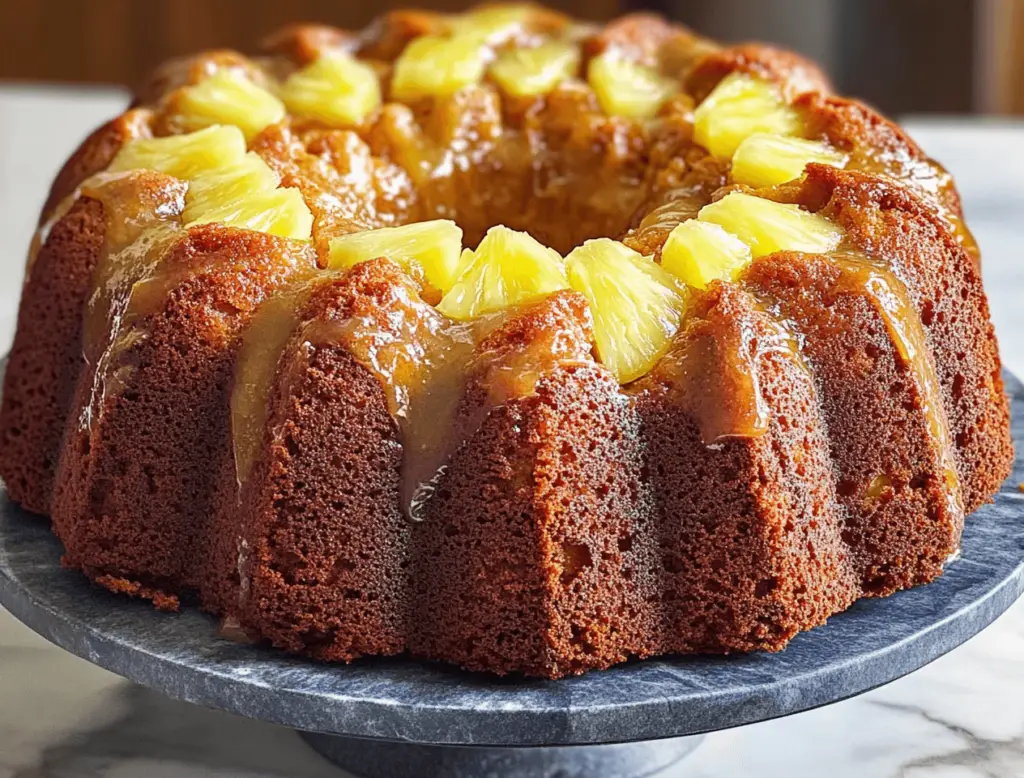Pineapple pound cake is a delightful twist on the classic pound cake, infusing a tropical flavor that instantly transports you to a sunny paradise. This cake combines the dense, buttery texture of traditional pound cake with the sweet and tangy taste of pineapple, creating a dessert that’s both rich and refreshing. Whether you’re serving it at a summer gathering, a holiday party, or as a special treat for yourself, pineapple pound cake is a versatile and crowd-pleasing dessert.

The origins of pound cake date back to 18th-century Europe, where it was traditionally made with a pound each of butter, sugar, eggs, and flour. Over time, this simple recipe has evolved, with countless variations emerging to suit different tastes and regions. Pineapple pound cake is one such variation, adding a burst of tropical flavor that complements the rich, buttery base. This cake is particularly popular in Southern cuisine, where it’s often served at family gatherings and special occasions.
In this article, we’ll guide you through everything you need to know to make the perfect pineapple pound cake. From the essential ingredients and tools to step-by-step instructions, you’ll be equipped with all the knowledge to bake a cake that’s sure to impress.
Overview of Pineapple Pound Cake
Pineapple pound cake is a moist, dense cake that combines the richness of a traditional pound cake with the bright, tangy flavor of pineapple. The cake is typically made with crushed pineapple, which is folded into the batter, infusing the cake with a subtle sweetness and a hint of tropical flair. The addition of sour cream or yogurt helps to keep the cake moist, while a touch of vanilla and almond extract enhances the flavor profile.
This cake is versatile enough to be served on its own or paired with a variety of toppings and accompaniments, such as whipped cream, fresh fruit, or a drizzle of glaze. It’s also a great base for creative variations—try adding coconut, nuts, or a citrus glaze to customize the cake to your liking.
Brief History and Cultural Significance
Pound cake has been a beloved dessert for centuries, with its origins rooted in the simplicity of using a pound of each main ingredient—flour, butter, eggs, and sugar. This recipe was easy to remember and required no precise measurements, making it accessible to home bakers long before the advent of modern kitchen scales and measuring tools. The traditional pound cake is known for its dense, rich texture and buttery flavor, qualities that have made it a staple in both European and American baking traditions.
The introduction of pineapple to the classic pound cake recipe likely occurred in the 20th century, when canned pineapple became widely available and popular in the United States. Pineapple’s sweet and tangy flavor, along with its association with tropical climates, made it an appealing addition to various desserts, including pound cake. In Southern cuisine, where pound cake is particularly cherished, the pineapple variation became a favorite for its vibrant flavor and moist texture.
Today, pineapple pound cake is enjoyed across the country, often featured at family gatherings, holiday celebrations, and summer parties. Its blend of traditional comfort and tropical flair makes it a versatile dessert that appeals to a wide range of palates.
Preparation Phase & Tools to Use
Prep Time: 20 minutes
Cook Time: 1 hour
Cool Time: 15 minutes
Total Time: 1 hour 35 minutes
Servings: 10-12 slices
Yield: 1 loaf
Essential Tools and Equipment
To make a pineapple pound cake, you’ll need the following tools:
- Mixing Bowls: Various sizes for combining wet and dry ingredients.
- Electric Mixer: To ensure the batter is smooth and well-mixed.
- Loaf Pan: A standard loaf pan or bundt pan, greased and floured to prevent sticking.
- Cooling Rack: To allow the cake to cool evenly after baking.
- Measuring Cups and Spoons: For precise measurement of ingredients.
- Spatula: To scrape down the sides of the bowl and ensure all ingredients are well-incorporated.
Importance of Each Tool
Each of these tools plays a crucial role in ensuring your pineapple pound cake turns out perfectly. The mixing bowls and electric mixer allow you to blend the ingredients thoroughly, creating a smooth and even batter. The loaf pan gives the cake its characteristic shape, while the cooling rack ensures that it cools evenly without becoming soggy. Accurate measurements with cups and spoons are essential for achieving the right texture and flavor, and a spatula helps to fully incorporate all ingredients, preventing any lumps or uneven mixing.
Preparation Tips
- Use Room Temperature Ingredients: Ensure that the butter, eggs, and sour cream are at room temperature before mixing. This helps them blend more smoothly, resulting in a better texture.
- Thoroughly Drain Pineapple: If using canned pineapple, make sure to drain it well and pat it dry with a paper towel to avoid adding excess moisture to the batter.
- Incorporate Fresh Pineapple: For a more vibrant flavor, you can use fresh pineapple instead of canned. Just be sure to chop it finely and remove any excess juice.
- Avoid Overmixing: When combining the wet and dry ingredients, mix just until combined. Overmixing can lead to a tough, dense cake.
- Test for Doneness: Since oven temperatures can vary, start checking the cake for doneness at the 60-minute mark. Insert a toothpick into the center of the cake—if it comes out clean or with a few crumbs attached, the cake is ready.
Ingredients List
- 1 1/2 cups unsalted butter, softened
- 2 cups granulated sugar
- 6 large eggs, room temperature
- 3 cups all-purpose flour
- 1 teaspoon baking powder
- 1/2 teaspoon salt
- 1 cup crushed pineapple, drained
- 1/2 cup sour cream
- 1 teaspoon vanilla extract
- 1/2 teaspoon almond extract (optional)
- Zest of 1 lemon (optional)
Step-by-Step Instructions
- Preheat the oven to 325°F (165°C). Grease and flour a loaf or bundt pan to prevent sticking.
- Cream the butter and sugar together in a large mixing bowl using an electric mixer on medium speed until light and fluffy, about 5 minutes.
- Add the eggs one at a time, beating well after each addition to ensure a smooth mixture.
- In a separate bowl, sift together the flour, baking powder, and salt. This helps to evenly distribute the leavening agents.
- Gradually add the dry ingredients to the butter mixture, alternating with the sour cream. Begin and end with the flour mixture, mixing just until combined.
- Fold in the crushed pineapple, vanilla extract, almond extract (if using), and lemon zest using a spatula. Make sure the pineapple is evenly distributed throughout the batter.
- Pour the batter into the prepared pan and smooth the top with a spatula to ensure even baking.
- Bake in the preheated oven for 60-70 minutes, or until a toothpick inserted into the center of the cake comes out clean or with a few moist crumbs attached.
- Cool the cake in the pan for 10-15 minutes before transferring it to a cooling rack to cool completely.
Serve your pineapple pound cake with a dusting of powdered sugar, a drizzle of glaze, or simply as is. Enjoy the delightful combination of rich pound cake and tropical pineapple flavor!
Side Dish Recommendations
1. Whipped Cream or Chantilly Cream
A dollop of whipped cream or Chantilly cream adds a light, airy texture that beautifully complements the dense, rich nature of pineapple pound cake. The subtle sweetness of the cream enhances the tropical flavors without overwhelming the cake’s natural taste. This classic pairing is perfect for an elegant dessert presentation, making it ideal for special occasions or dinner parties.
2. Vanilla Ice Cream
Vanilla ice cream is a classic companion for many desserts, and it pairs exceptionally well with pineapple pound cake. The cool, creamy texture of the ice cream provides a delightful contrast to the warm, buttery cake. The vanilla flavor enhances the tropical notes of the pineapple, creating a harmonious blend of flavors that is both comforting and refreshing.
3. Fresh Fruit Salad
A vibrant fresh fruit salad made with tropical fruits like mango, papaya, kiwi, and additional pineapple adds a burst of color and flavor to your dessert plate. The natural sweetness and acidity of the fruit complement the richness of the pound cake, making it a refreshing side that balances the cake’s buttery texture.
4. Coconut Sorbet
For a more exotic twist, serve your pineapple pound cake with a scoop of coconut sorbet. The creamy yet light texture of the sorbet, combined with its mild coconut flavor, complements the pineapple in the cake, creating a tropical dessert experience. This combination is especially appealing during the warmer months.
5. Pineapple Compote
Enhance the pineapple flavor of your pound cake by serving it with a warm pineapple compote. Made by simmering pineapple chunks with sugar, a touch of butter, and a hint of cinnamon, this compote adds a sweet, syrupy layer of flavor that moistens the cake and elevates its tropical essence.
6. Lemon Glaze
A tangy lemon glaze drizzled over the pineapple pound cake adds a zesty contrast to the sweetness of the cake. The citrus notes from the lemon highlight the bright, fruity flavors of the pineapple, while the glaze itself adds a glossy finish that makes the cake even more visually appealing. This option is perfect for those who enjoy a bit of tartness in their desserts.
7. Caramel Sauce
For a richer, more indulgent experience, pair your pineapple pound cake with a drizzle of warm caramel sauce. The buttery, sweet caramel complements the cake’s flavors, adding a decadent touch that makes each bite more luxurious. This combination is ideal for dessert lovers who appreciate a deep, complex sweetness.
8. Toasted Coconut Flakes
Sprinkle toasted coconut flakes over your pineapple pound cake to add a crunchy texture and a nutty flavor that enhances the tropical theme of the dessert. The coconut flakes not only provide a delightful contrast to the cake’s soft crumb but also introduce an additional layer of flavor that pairs wonderfully with the pineapple.
Nutritional Information & Health Benefits
Understanding the nutritional content of pineapple pound cake can help you enjoy this indulgent dessert in moderation. Here is a general breakdown of the nutritional information per serving (approximately one slice):
- Calories: 350
- Total Fat: 18g
- Saturated Fat: 10g
- Cholesterol: 90mg
- Sodium: 180mg
- Total Carbohydrates: 45g
- Dietary Fiber: 1g
- Sugars: 30g
- Protein: 4g
Health Benefits:
- Pineapple: Pineapple is rich in vitamin C, which supports immune function, and manganese, which is important for bone health and metabolism. The natural enzymes in pineapple, such as bromelain, can aid in digestion.
- Sour Cream: The sour cream in the recipe adds moisture to the cake and is a source of calcium, which is essential for healthy bones and teeth.
- Moderation: While pineapple pound cake is a treat that’s high in sugar and fat, enjoying it in moderation can be part of a balanced diet. Pairing it with fresh fruits or lighter accompaniments can help balance the richness.
Common Mistakes To Avoid & How to Perfect the Recipe
1. Overmixing the Batter
- Mistake: Overmixing the batter can lead to a dense, tough cake because it overdevelops the gluten in the flour.
- Solution: Mix the batter just until the ingredients are combined. Stop as soon as you no longer see streaks of flour to maintain a light, tender crumb.
2. Using Cold Ingredients
- Mistake: Using cold butter, eggs, or sour cream can cause the batter to curdle and result in uneven mixing.
- Solution: Make sure all ingredients are at room temperature before starting the recipe. This ensures that the ingredients blend together smoothly, creating a uniform batter and a better texture.
3. Not Draining the Pineapple Properly
- Mistake: Failing to drain the crushed pineapple thoroughly can add too much moisture to the batter, leading to a soggy or dense cake.
- Solution: After draining the pineapple, press it gently with a paper towel to remove any excess juice. This will help maintain the correct moisture balance in the cake.
4. Overbaking
- Mistake: Overbaking can dry out the cake, making it less enjoyable.
- Solution: Start checking the cake for doneness at the lower end of the suggested baking time. Insert a toothpick into the center of the cake—if it comes out clean or with a few moist crumbs, the cake is done. Also, make sure your oven temperature is accurate, as an oven that runs too hot can lead to overbaking.
5. Not Preheating the Oven
- Mistake: Placing the cake in a cold oven can result in uneven baking, with the outer edges cooking faster than the center.
- Solution: Always preheat your oven to the correct temperature before placing the cake inside. This ensures that the cake bakes evenly and rises properly.
6. Uneven Distribution of Pineapple
- Mistake: If the pineapple is not evenly distributed in the batter, some slices may lack the desired flavor and moisture.
- Solution: After folding in the pineapple, gently stir the batter to ensure that the pineapple is evenly spread throughout. This will give each slice of cake a consistent flavor and texture.
7. Using the Wrong Pan
- Mistake: Using a pan that is too small or too large can affect the baking time and the cake’s texture.
- Solution: Stick to the recommended pan size (typically a 9×5-inch loaf pan or a bundt pan). If using a different size, adjust the baking time accordingly and check for doneness earlier or later than the recipe suggests.
By following these tips and avoiding common mistakes, you’ll be able to bake a pineapple pound cake that’s moist, flavorful, and perfectly textured every time. Enjoy your cake with your choice of side dishes and savor the tropical delight in each bite!
Tips, Notes, Storing, and Reheating
Tips and Notes
- Pineapple Variations: Consider using a combination of fresh and canned pineapple for added texture and flavor. Fresh pineapple adds a vibrant, juicy element, while canned pineapple brings a consistent sweetness.
- Add Coconut: For a more tropical twist, fold in 1/2 cup of shredded coconut into the batter or sprinkle it on top before baking.
- Use Lemon or Lime Zest: Incorporate a teaspoon of lemon or lime zest into the batter for an extra citrusy kick that complements the pineapple flavor.
- Pineapple Glaze: Enhance the cake by drizzling a simple pineapple glaze over the top. Mix powdered sugar with a bit of pineapple juice until it reaches a drizzling consistency.
- Avoid Overbaking: Check your cake a few minutes before the recommended baking time is up. Overbaking can dry out the cake, so it’s better to err on the side of caution.
Storing Pineapple Pound Cake
- Room Temperature: Pineapple pound cake can be stored at room temperature for up to 3 days. Wrap it tightly in plastic wrap or store it in an airtight container to keep it fresh.
- Refrigerator: To extend its freshness, store the cake in the refrigerator for up to a week. Make sure it’s well-wrapped to prevent it from drying out.
- Freezer: Pineapple pound cake freezes well. Wrap the cake tightly in plastic wrap, then in aluminum foil, and store it in the freezer for up to 2 months. Thaw it in the refrigerator or at room temperature before serving.
Reheating Pineapple Pound Cake
- Microwave: To quickly reheat a slice of pineapple pound cake, place it on a microwave-safe plate and heat on medium power for 10-15 seconds. Be careful not to overheat, as this can make the cake dry.
- Oven: Preheat your oven to 300°F (150°C). Place the cake on a baking sheet and cover it with foil. Reheat for 10-15 minutes, or until warmed through. This method helps to restore some of the cake’s moisture and softness.
- Toaster Oven: If you’re reheating just a slice or two, a toaster oven is a great option. Set it to a low temperature and heat for 5-7 minutes.
FAQs
1. Can I make pineapple pound cake with fresh pineapple instead of canned?
Yes, fresh pineapple can be used instead of canned. Just make sure to finely chop the pineapple and drain any excess juice to prevent the cake from becoming too moist. Fresh pineapple will add a slightly tangier flavor and a firmer texture.
2. What can I use as a substitute for sour cream in the recipe?
You can substitute sour cream with plain Greek yogurt or buttermilk. Both options will provide a similar level of moisture and tanginess. Greek yogurt will make the cake slightly denser, while buttermilk will give it a lighter texture.
3. How can I prevent my pineapple pound cake from sticking to the pan?
To prevent sticking, thoroughly grease and flour the loaf or bundt pan before pouring in the batter. You can also use a non-stick baking spray that contains flour. Additionally, consider lining the bottom of the pan with parchment paper for extra insurance.
4. Why did my cake turn out dense and heavy?
A dense cake can result from overmixing the batter, using cold ingredients, or adding too much flour. Make sure to mix the batter just until the ingredients are combined and use room-temperature ingredients to ensure a smooth, even batter. Measuring the flour correctly (spoon and level method) can also help avoid a dense texture.
5. Can I add other fruits or nuts to the pineapple pound cake?
Absolutely! Chopped nuts like pecans or walnuts, shredded coconut, or even other fruits like maraschino cherries can be added to the batter. Just be sure not to add too much, as this can affect the cake’s texture and baking time.
6. How do I make the cake more moist?
Ensuring the proper ratio of wet to dry ingredients is key. Using ingredients like sour cream or yogurt adds moisture to the cake. Avoid overbaking, as this can dry out the cake. If you prefer an even moister cake, consider brushing a simple syrup (made with sugar and water) over the cake while it’s still warm.
7. What is the best way to serve pineapple pound cake?
Pineapple pound cake is versatile and can be served in various ways. Serve it plain or with a dusting of powdered sugar, or top it with a simple glaze or fresh whipped cream. For a more decadent dessert, pair it with vanilla ice cream or a fruit compote.
8. Can I use this recipe to make cupcakes or mini loaves?
Yes, the batter can be used to make cupcakes or mini loaves. Adjust the baking time accordingly—cupcakes typically take about 20-25 minutes, while mini loaves may take 30-35 minutes. Always check for doneness by inserting a toothpick into the center.
9. How do I store leftover pineapple pound cake?
Store leftover pineapple pound cake at room temperature in an airtight container for up to 3 days. For longer storage, refrigerate the cake for up to a week or freeze it for up to 2 months.
10. Can I make pineapple pound cake ahead of time?
Yes, pineapple pound cake can be made ahead of time. It’s actually one of those cakes that often tastes better the next day after the flavors have had time to meld. Store it in an airtight container at room temperature or in the refrigerator until ready to serve.
Conclusion
Pineapple pound cake is a delightful dessert that brings a taste of the tropics to your table. Its rich, buttery texture combined with the sweet, tangy flavor of pineapple makes it a versatile treat that can be enjoyed on its own or paired with various toppings and accompaniments. By following the tips and techniques outlined in this article, you can perfect your pineapple pound cake recipe and create a dessert that’s sure to impress. Whether you’re serving it at a family gathering, a holiday celebration, or simply enjoying a slice with your afternoon tea, this cake is bound to become a favorite. Enjoy every bite of this tropical delight!
Print
Pineapple Pound Cake
Description
Discover the best pineapple pound cake recipe. Moist, buttery, and full of tropical flavor, this cake is perfect for any occasion.
Ingredients
Ingredients List
- 1 1/2 cups unsalted butter, softened
- 2 cups granulated sugar
- 6 large eggs, room temperature
- 3 cups all-purpose flour
- 1 teaspoon baking powder
- 1/2 teaspoon salt
- 1 cup crushed pineapple, drained
- 1/2 cup sour cream
- 1 teaspoon vanilla extract
- 1/2 teaspoon almond extract (optional)
- Zest of 1 lemon (optional)
Instructions
- Preheat the oven to 325°F (165°C). Grease and flour a loaf or bundt pan to prevent sticking.
- Cream the butter and sugar together in a large mixing bowl using an electric mixer on medium speed until light and fluffy, about 5 minutes.
- Add the eggs one at a time, beating well after each addition to ensure a smooth mixture.
- In a separate bowl, sift together the flour, baking powder, and salt. This helps to evenly distribute the leavening agents.
- Gradually add the dry ingredients to the butter mixture, alternating with the sour cream. Begin and end with the flour mixture, mixing just until combined.
- Fold in the crushed pineapple, vanilla extract, almond extract (if using), and lemon zest using a spatula. Make sure the pineapple is evenly distributed throughout the batter.
- Pour the batter into the prepared pan and smooth the top with a spatula to ensure even baking.
- Bake in the preheated oven for 60-70 minutes, or until a toothpick inserted into the center of the cake comes out clean or with a few moist crumbs attached.
- Cool the cake in the pan for 10-15 minutes before transferring it to a cooling rack to cool completely.
Notes
- Pineapple Variations: Consider using a combination of fresh and canned pineapple for added texture and flavor. Fresh pineapple adds a vibrant, juicy element, while canned pineapple brings a consistent sweetness.
- Add Coconut: For a more tropical twist, fold in 1/2 cup of shredded coconut into the batter or sprinkle it on top before baking.
- Use Lemon or Lime Zest: Incorporate a teaspoon of lemon or lime zest into the batter for an extra citrusy kick that complements the pineapple flavor.
- Pineapple Glaze: Enhance the cake by drizzling a simple pineapple glaze over the top. Mix powdered sugar with a bit of pineapple juice until it reaches a drizzling consistency.
- Avoid Overbaking: Check your cake a few minutes before the recommended baking time is up. Overbaking can dry out the cake, so it’s better to err on the side of caution.


Leave a Comment